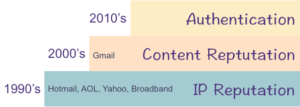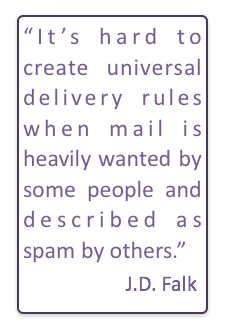IP Repuation
Let’s Talk: Reputation
The next 3 or 4 Let’s Talk sessions are going to be all about reputation. We’ll start with a general overview of reputation and identity, then move on to specific kinds of reputation (IP, domain, URL, content), then we’ll talk about how to create, maintain and repair reputation. Still working on the outline, but I’m pretty convinced this will be at least 3 sessions.
Read MoreAnother way Gmail is different
I was answering a question on Mailop earlier today and had one of those moments of clarity. I finally managed to articulate one of the things I’ve known about Gmail, but never been able to explain. See, Gmail has never really put a lot of their filtering on the SMTP transaction and IP reputation. Other ISPs do a lot of the heavy lifting with IP filters. But not Gmail.
While I was writing the answer I realized something. Gmail was a late entrant into the email space. AOL, Hotmail, Yahoo, even the cable companies, were providing email services in the 90s. When spam started to be a problem, they started with IP based blocking. As technology got better and content filtering became viable, improvements were layered on top of IP based blocking.
Gmail didn’t enter the mailbox market until the 2000’s. When they did, they had money, lots of hardware, and internal expertise to do content filtering. They didn’t start with IP based filtering, so their base is actually content filtering. Sure, there were some times when they’d push some mail away from the MTAs, but most of their filtering was done after the SMTP transaction. The short version of this is I never really pay any attention to IP reputation when dealing with Gmail. It’s just another factor. Unless you’re blocked and if you get blocked by Gmail, wow, you really screwed up.
Gmail does, of course, do some IP based blocking. But in my experience IP filters are really only turned against really egregious spam, phishing and malicious mail. Most email marketers reading my blog won’t ever see IP filters at Gmail because their mail is not that bad.
Other companies aren’t going to throw away filters that are working, so the base of their filters are IPs. But Google never had that base to work from. Their base is content filters, with some IP rep layered on top of that.
That’s a big reason Gmail filters are different from other filters.
Deliverability and IP addresses
Almost 2 years ago I wrote a blog post titled The Death of IP Based Reputation. These days I’m even more sure that IP based reputation is well and truly dead for legitimate senders.
There are a lot of reasons for this continued change. 
Why do we "warmup" IP addresses
IP address warmup is a big issue for anyone moving to a new IP address for sending.
I’m constantly being asked how to warm up an IP. My answer is always the same. There’s no right way to warm up an IP nor is there a specific formula that everyone should follow.
What warming up is about is introducing mail traffic to receiving spam filters in a way that lets the filter know this is a legitimate email stream. This means sending small but regular amounts of mail that recipients interact with. As the filters adjust to the amount of mail from that IP, more mail can be sent over that IP. Increase the mail volume over the next few weeks until the desired volume is reached.
There are a couple things to remember about warming up.
Delivery challenges increasing
Return Path published their most recent Global Deliverability report this morning. (Get the Report) This shows that inbox placement of mail has decreased 6% in the second half of 2011. This decrease is the largest decrease Return Path has seen in their years of doing this report.
To be honest, I’m not surprised at the decrease. Filters are getting more sophisticated. This means they’re not relying on simply IP reputation for inbox delivery any longer. IP reputation gets mail through the SMTP transaction, but after that mail is subject to content filters. Those content filters are getting a lot better at sorting out “wanted” from “unwanted” mail.
I’m also hearing a lot of anecdotal reports that bulk folder placements at a couple large ISPs increased in the first quarter of 2012. This is after the RP study was finished, and tells me increased bulk folder placement is more likely to be a trend and not a blip.
One of the other interesting things from the RP study is that the differences are not across all mail streams, but are concentrated in certain streams and they vary across different regions.
Spamhaus rising?
Ken has a good article talking about how many ESPs have tightened their standards recently and are really hounding their customers to stop sending mail recipients don’t want and don’t like. Ken credits much of this change to Spamhaus and their new tools.
Read More